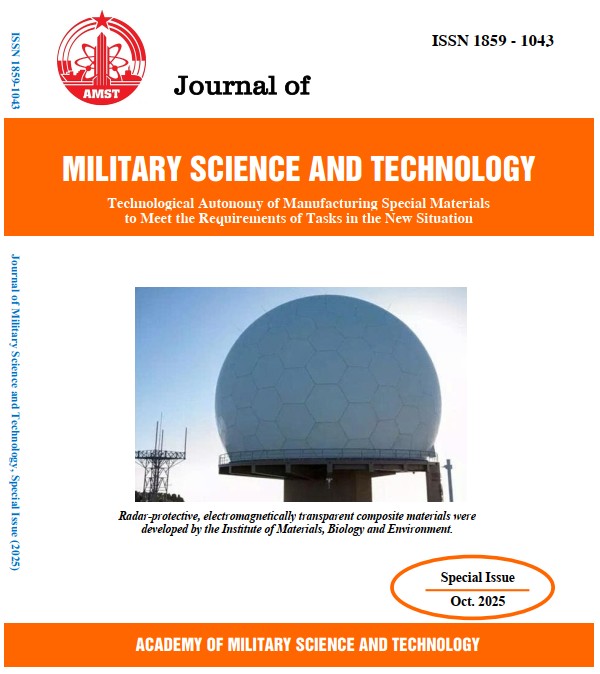Synthesis of gel beads based on pectin extracted from dragon fruit stems and investigation of the effect of gel properties on the adsorption capacity of methyl orange
DOI:
https://doi.org/10.54939/1859-1043.j.mst.IMBE.2025.172-178Keywords:
Pectin; Polysaccharide; Dragon fruit stem; Adsorption; Methyl orange.Abstract
In this study, polysaccharide gel beads (PS) extracted from dragon fruit stems were employed as adsorbents for the removal of Methyl Orange (MO) dye from aqueous solutions. The physicochemical properties of the PS were characterized by scanning electron microscopy (SEM), Fourier-transform infrared spectroscopy (FTIR), and Brunauer–Emmett–Teller (BET) surface area analysis. The influence of polymer concentration, pectin-to-alginate ratio, filler content, and gelation time on gel formation efficiency was systematically evaluated. Optimal gelation was achieved at a polymer concentration of 3%w/v, a pectin-to-alginate ratio of 1:1, a filler content of 60%w/v, and a gelation time of 60 min. Under these conditions, the PS demonstrated excellent adsorption performance, attaining a removal efficiency of 88.95% for MO after 120 min. These findings highlight the considerable potential of dragon fruit-derived polysaccharides for fabricating gel-based adsorbents applicable to the treatment of dye-containing wastewater.
References
[1]. J. Kim et al., “Functionalization of pine sawdust biochars with Mg/Al layered double hydroxides to enhance adsorption capacity of synthetic azo dyes: Adsorption mechanisms and reusability”, Heliyon, Vol. 9, No. 3, pp. e14142, (2023).
[2]. N. X. Loc et al., “Chitosan-Modified Biochar and Unmodified Biochar for Methyl Orange: Adsorption Characteristics and Mechanism Exploration”, Toxics, Vol. 10, No. 9, pp. 500, (2022).
[3]. M.-C. Stanciu et al., “Natural Polysaccharide-Based Hydrogels Used for Dye Removal”, Heliyon, Vol. 10, No. 4, pp. 243, (2024).
[4]. G. Annadurai et al., “Use of cellulose-based wastes for adsorption of dyes from aqueous solutions”, Journal of Hazardous Materials, Vol. 92, No. 3, pp. 263–274, (2002).
[5]. M. V. Subbaiah et al., “Carboxylate-functionalized dragon fruit peel powder as an effective adsorbent for the removal of Rhodamine B (cationic dye) from aqueous solution: adsorption behavior and mechanism”, International Journal of Phytoremediation, Vol. 25, No. 2, pp. 146–160, (2023).
[6]. R. D. Chrisnandari et al., “Utilization of Activated Carbon Derived from Dragon Fruit Foliage Using Strong Acid Activator as a Lead (Pb) Metal Adsorbent”, Reka Buana: Jurnal Ilmiah Teknik Sipil dan Teknik Kimia, Vol. 7, No. 2, pp. 141–158, (2022).
[7]. T. P. Chien et al., “Characteristics of pectin extracted from dragon fruit stems in Binh Thuan, Vietnam and gel formation method”, Journal of Military Science and Technology, pp. 268–273, (2024).
[8]. J. Park et al., “Effect of Polymer Solution Concentration on the Swelling and Mechanical Properties of Glycol Chitosan Superporous Hydrogels”, Journal of Applied Polymer Science, Vol. 115, No. 6, pp. 3434–3441, (2010).
[9]. L. Chan et al., “Crosslinking mechanisms of calcium and zinc production of alginate microspheres”, International Journal of Pharmaceutics, Vol. 242, No. 1–2, pp. 255–258, (2002).
[10]. P. Kiaei Pour et al., “Potential effects of alginate-pectin biocomposite on the release of folic acid and their physicochemical characteristics”, J Food Sci Technol, Vol. 57, No. 9, pp. 3363–3370, (2020).
[11]. F. Wang et al., “Structural Analysis and Study of Gel Properties of Thermally-Induced Soybean Isolate-Potato Protein Gel System”, Foods, Vol. 11, No. 22, pp. 3562, (2022).
[12]. F. Olawuyi et al., “Enzymatic Hydrolysis Modifies Emulsifying Properties of Okra Pectin”, Foods, Vol. 11, No. 10, pp. 1497, (2022).
[13]. H. Cheng et al., “Adsorption performance and mechanism of iron-loaded biochar to methyl orange in the presence of Cr6+ from dye wastewater”, Journal of Hazardous Materials, Vol. 415, pp. 125749, (2021).
[14]. D. Dai et al., “Investigation of the dislocation of natural fibers by Fourier-transform infrared spectroscopy”, Vibrational Spectroscopy, Vol. 55, No. 2, pp. 300–306, (2011).
[15]. S. de Bruin et al., “FT-IR micro-spectroscopy for imaging the extracellular matrix composition in biofilms”, bioRxiv, pp. 2024–2008, (2024).
[16]. Chen et al., “Enhanced Adsorption of Methyl Orange from Aqueous Phase Using Chitosan–Palmer Amaranth Biochar Composite Microspheres”, Molecules, Vol. 29, No. 8, pp. 1836, (2024).
[17]. Guo et al., “Synergistic effect of hydrogen bonding and π-π interaction for enhanced adsorption of rhodamine B from water using corn straw biochar”, Environmental Pollution, pp. 121060, (2023).







